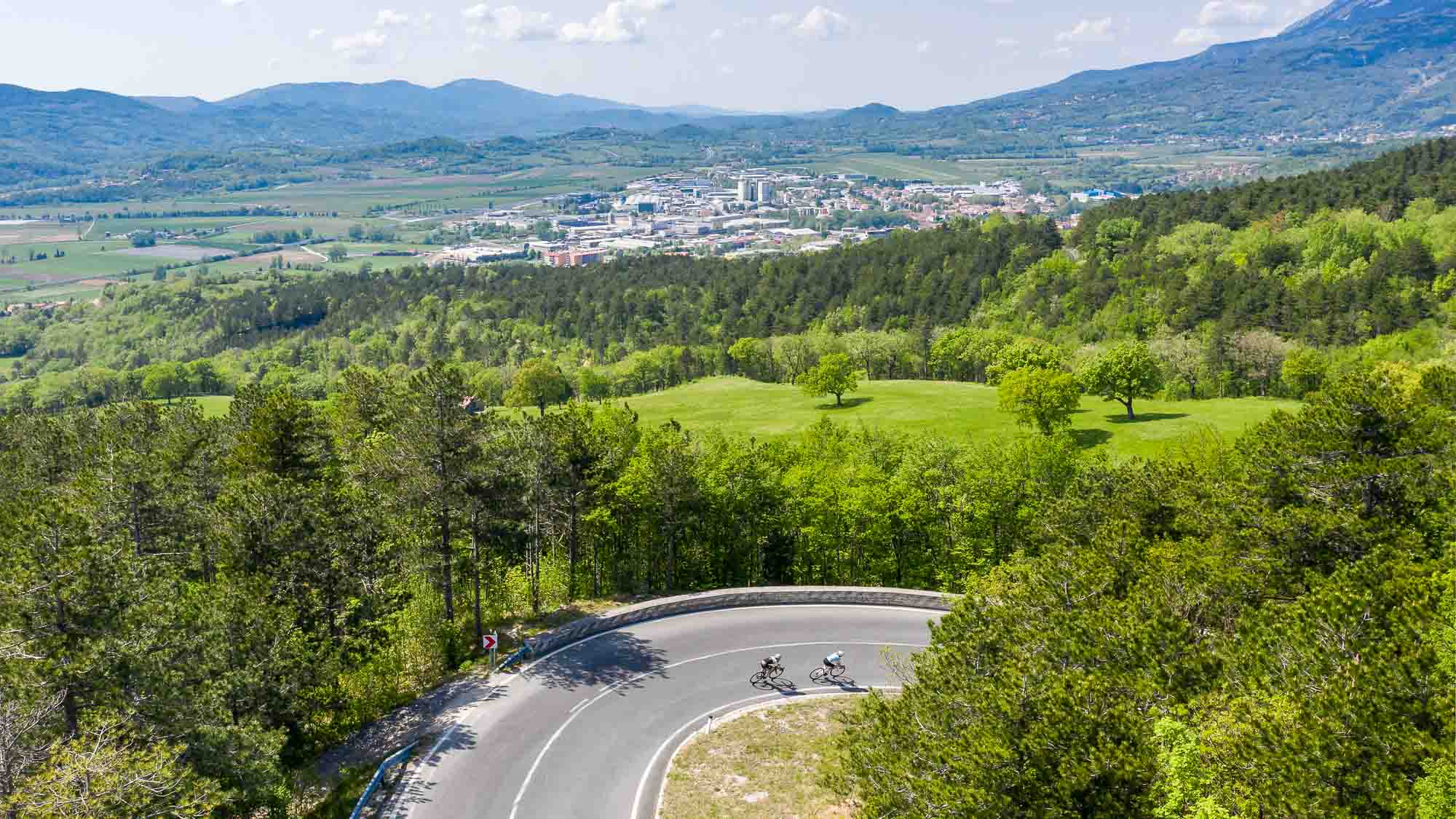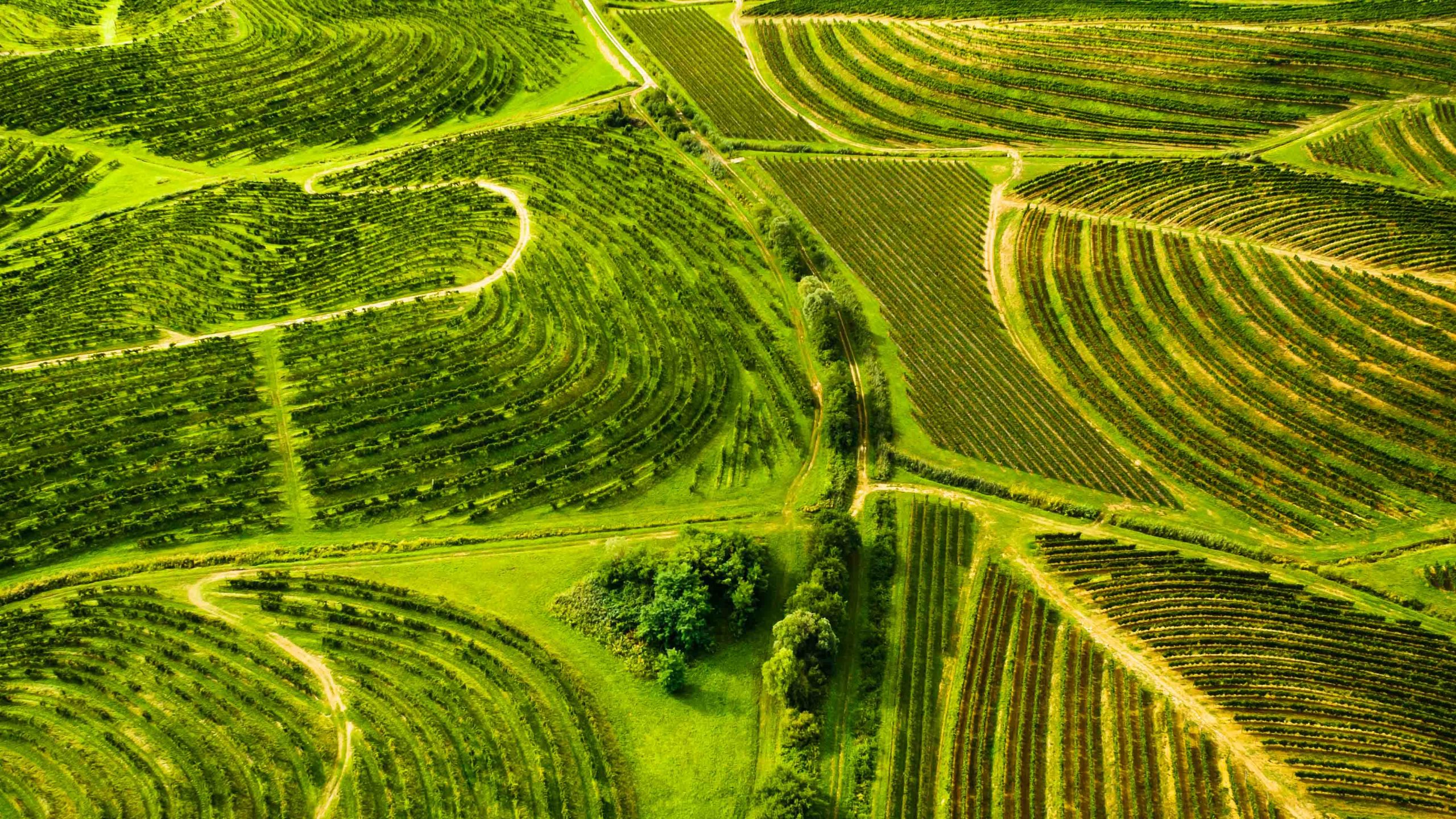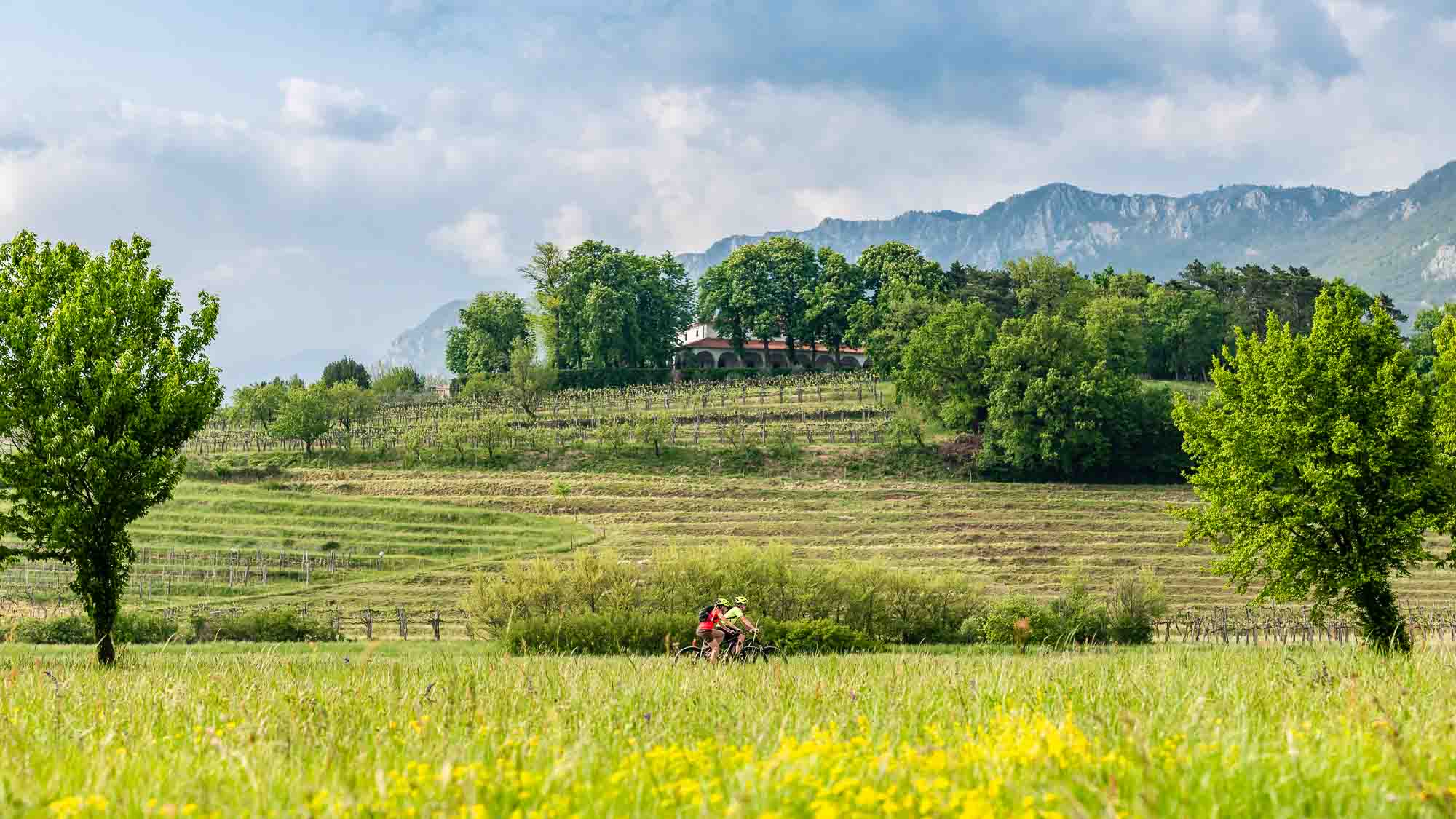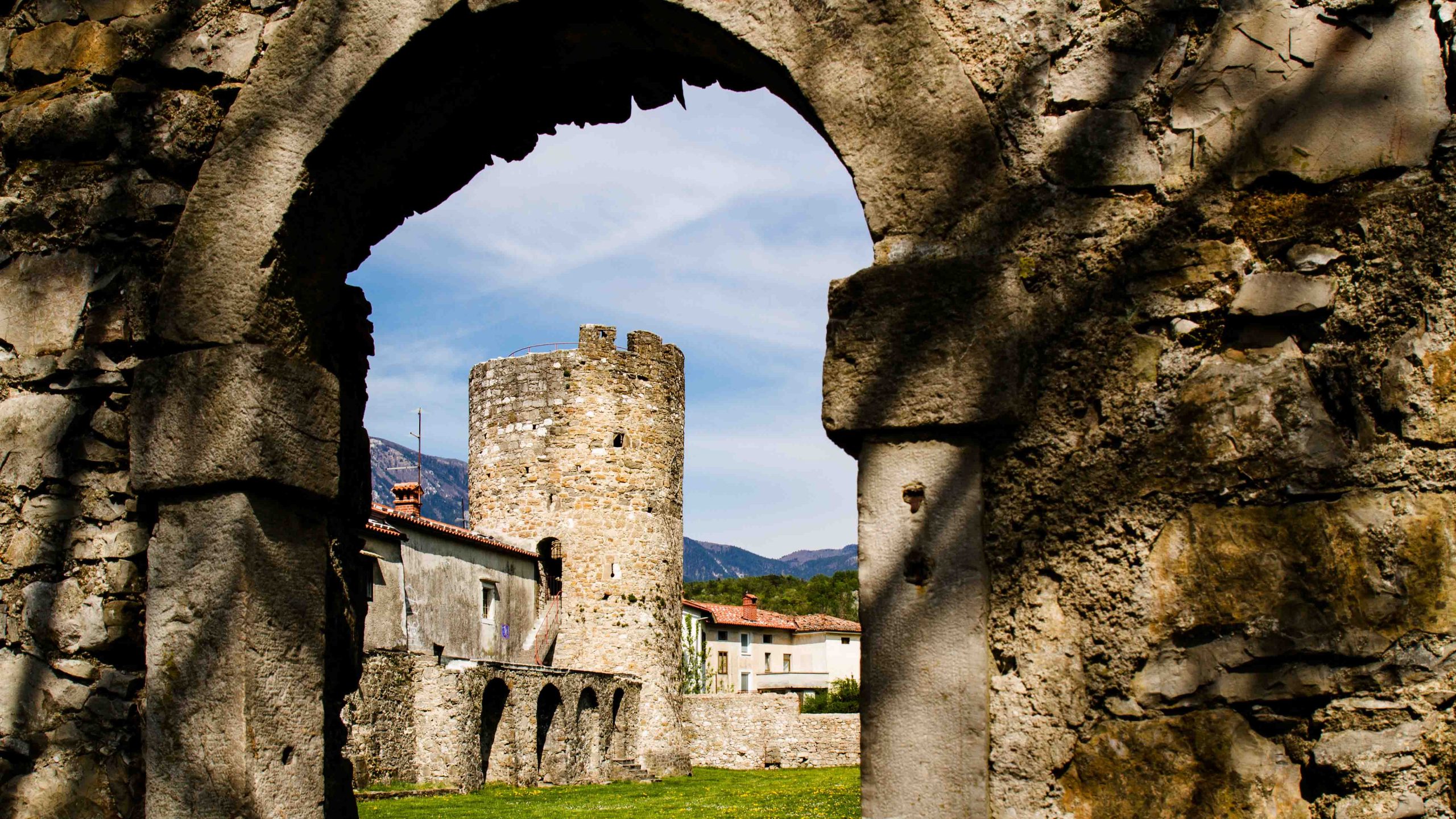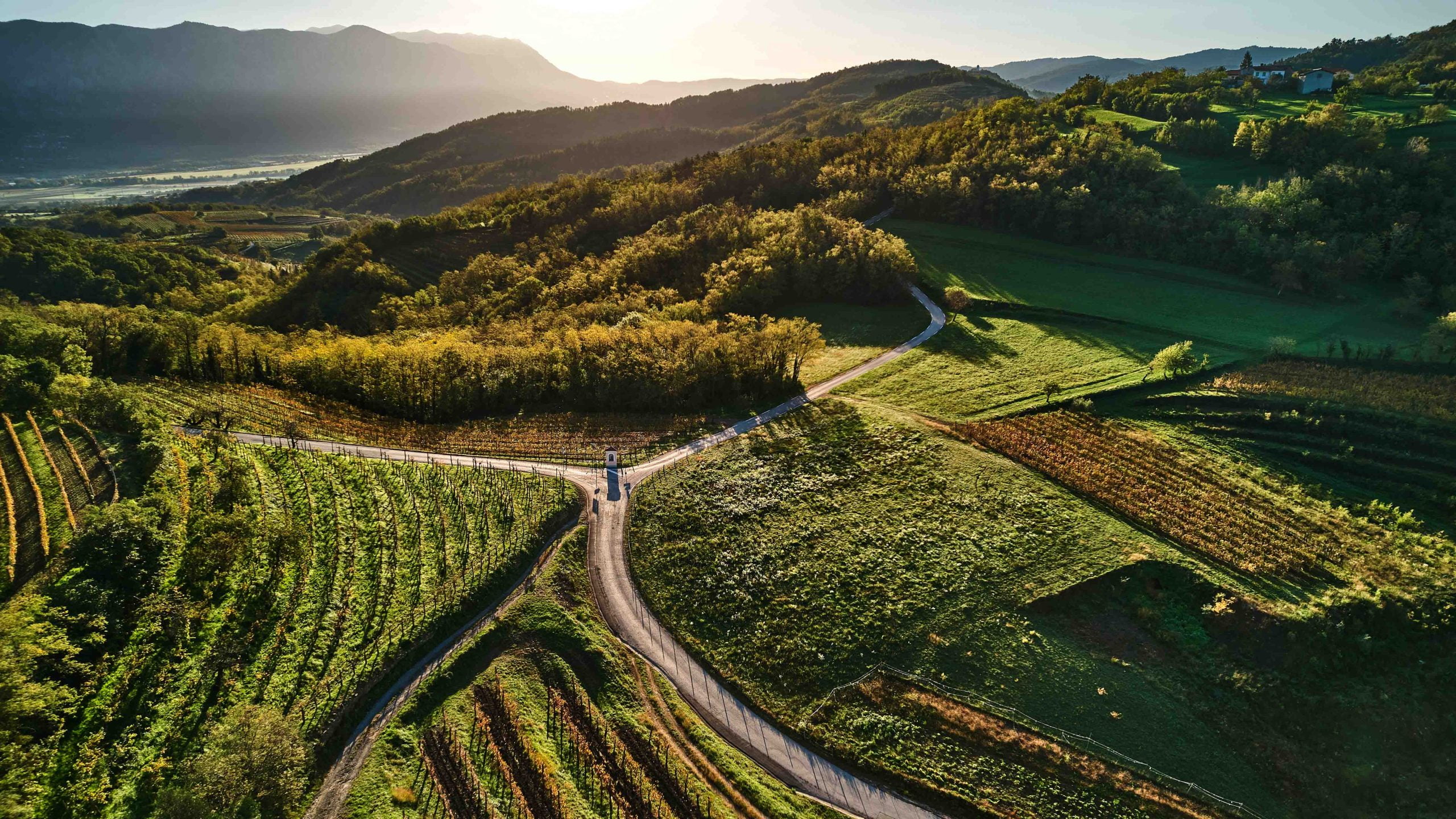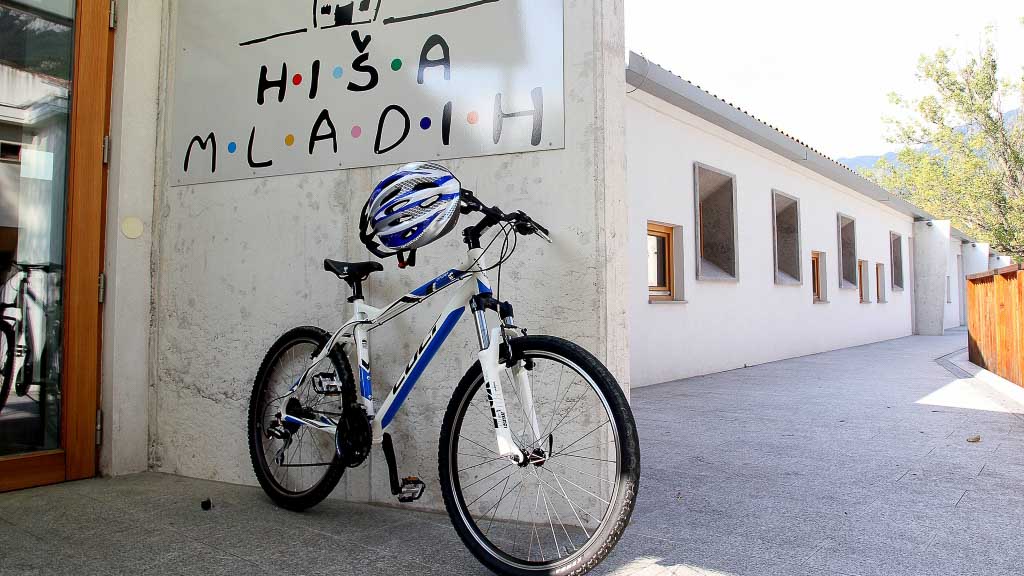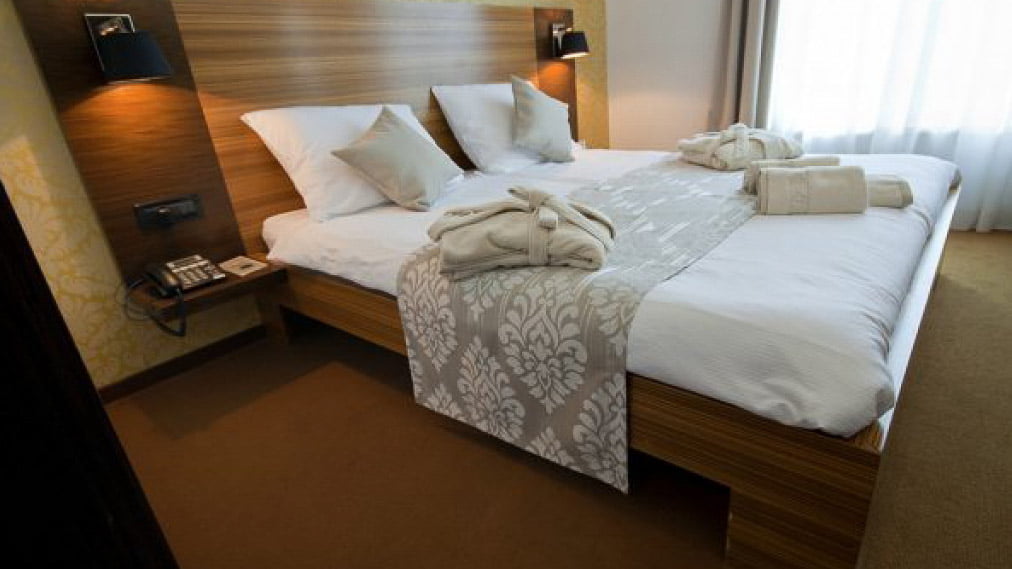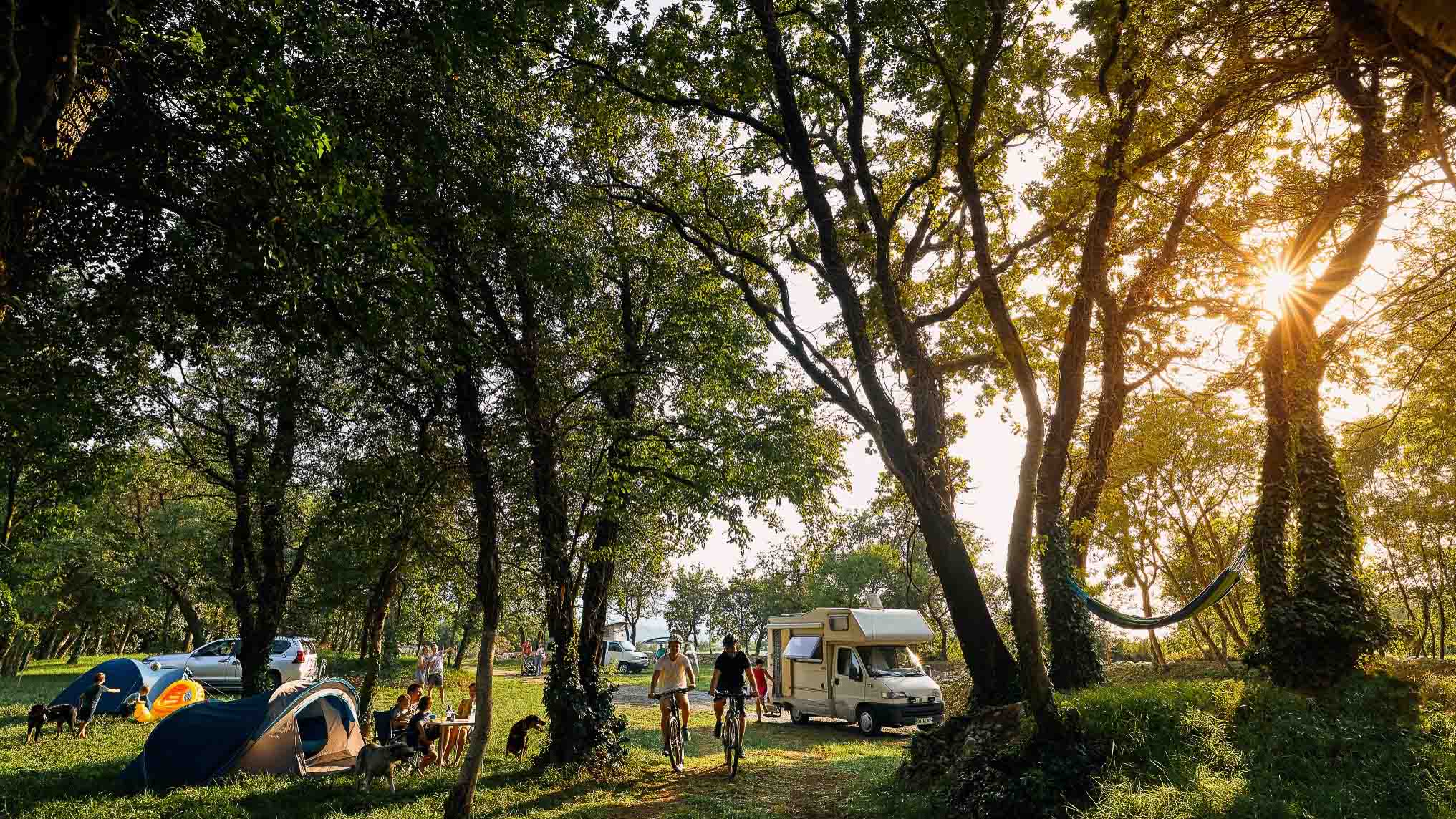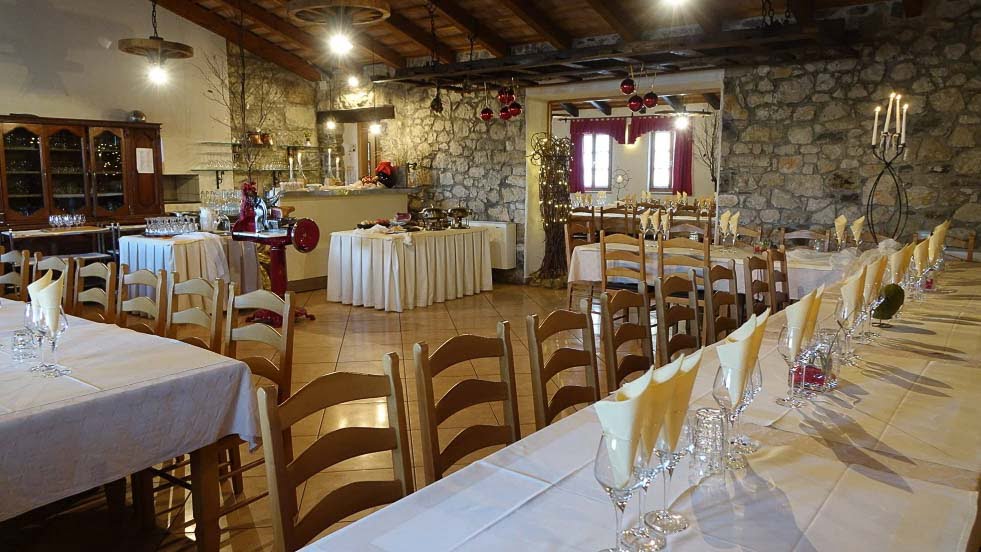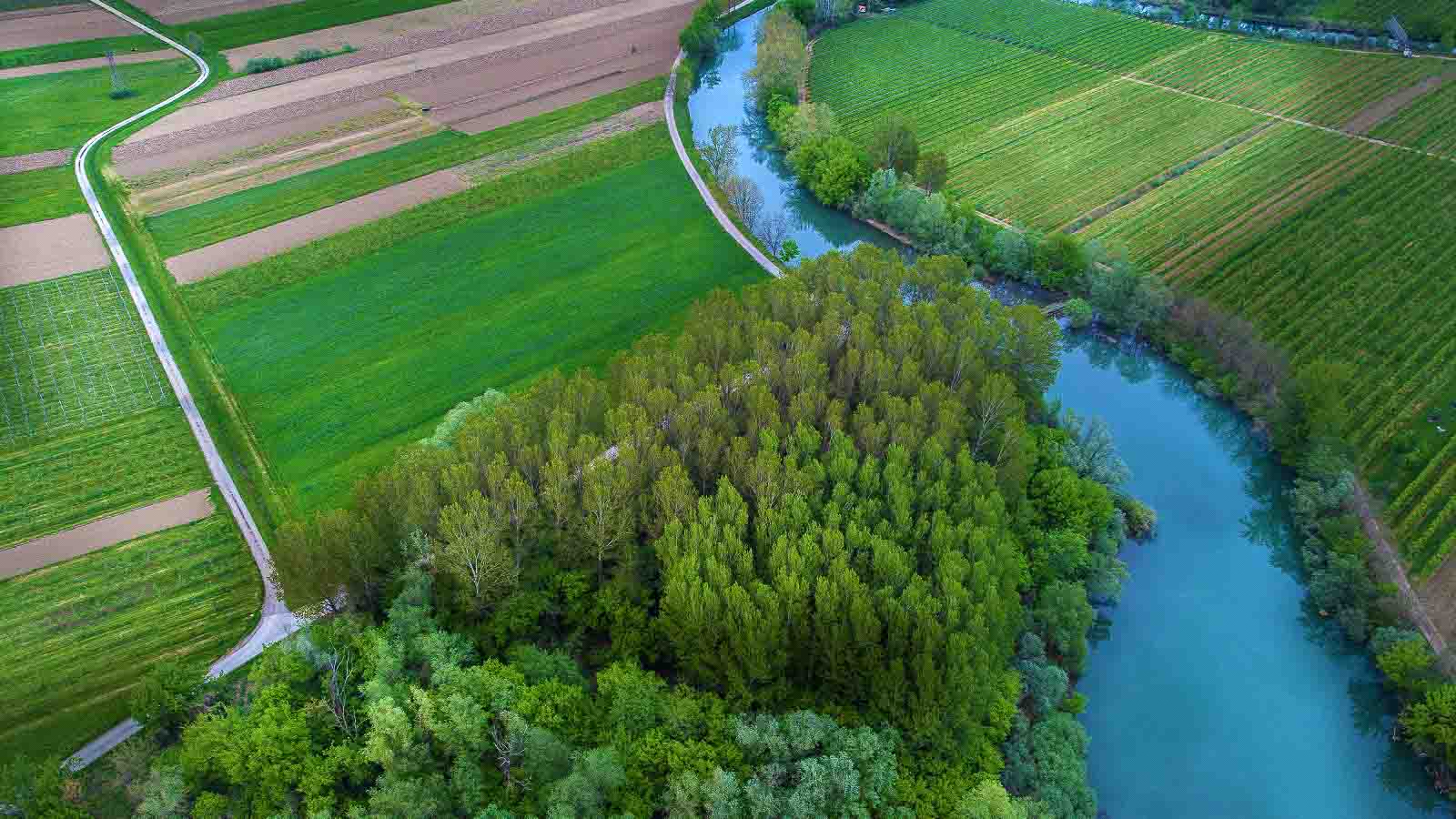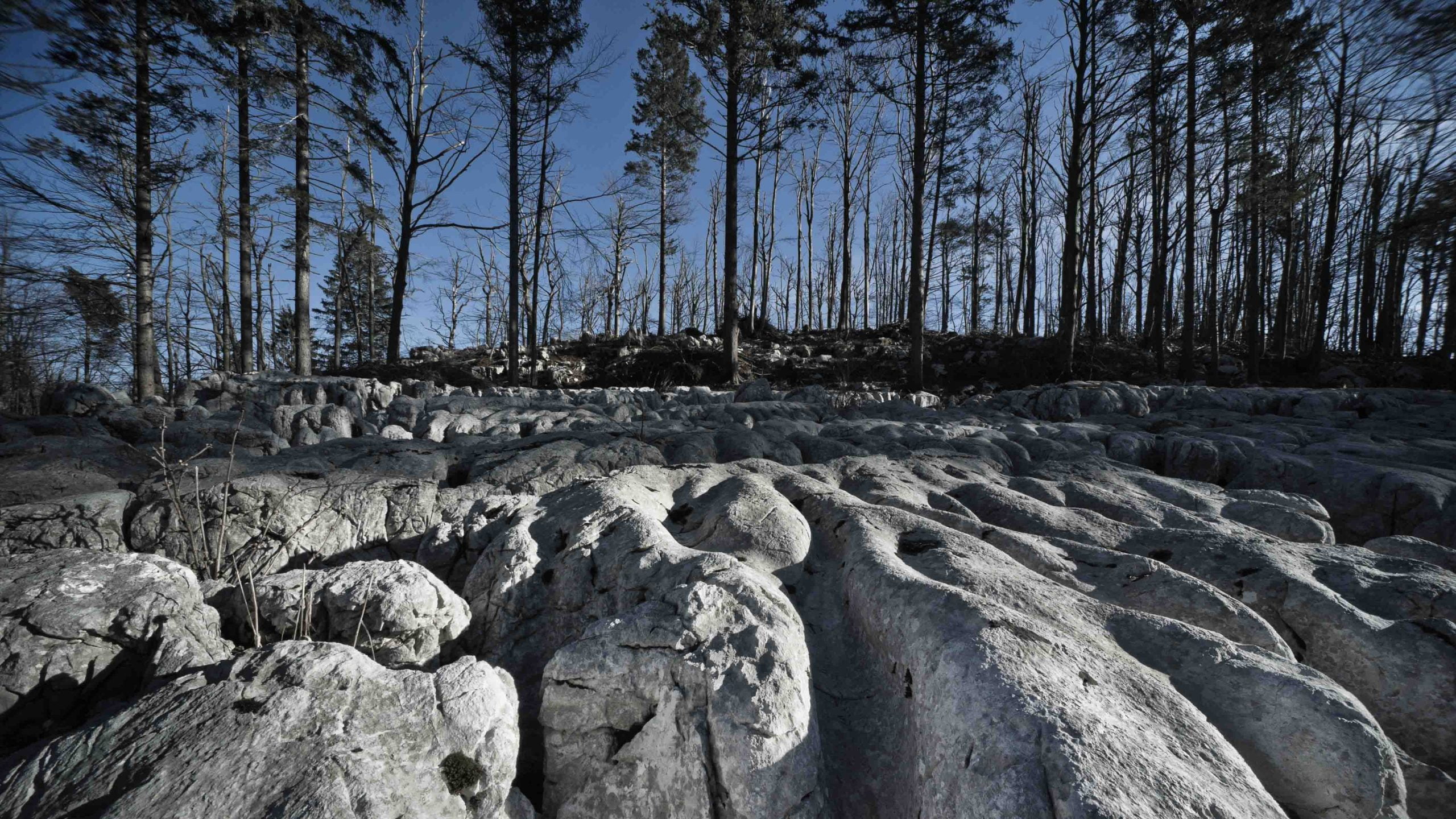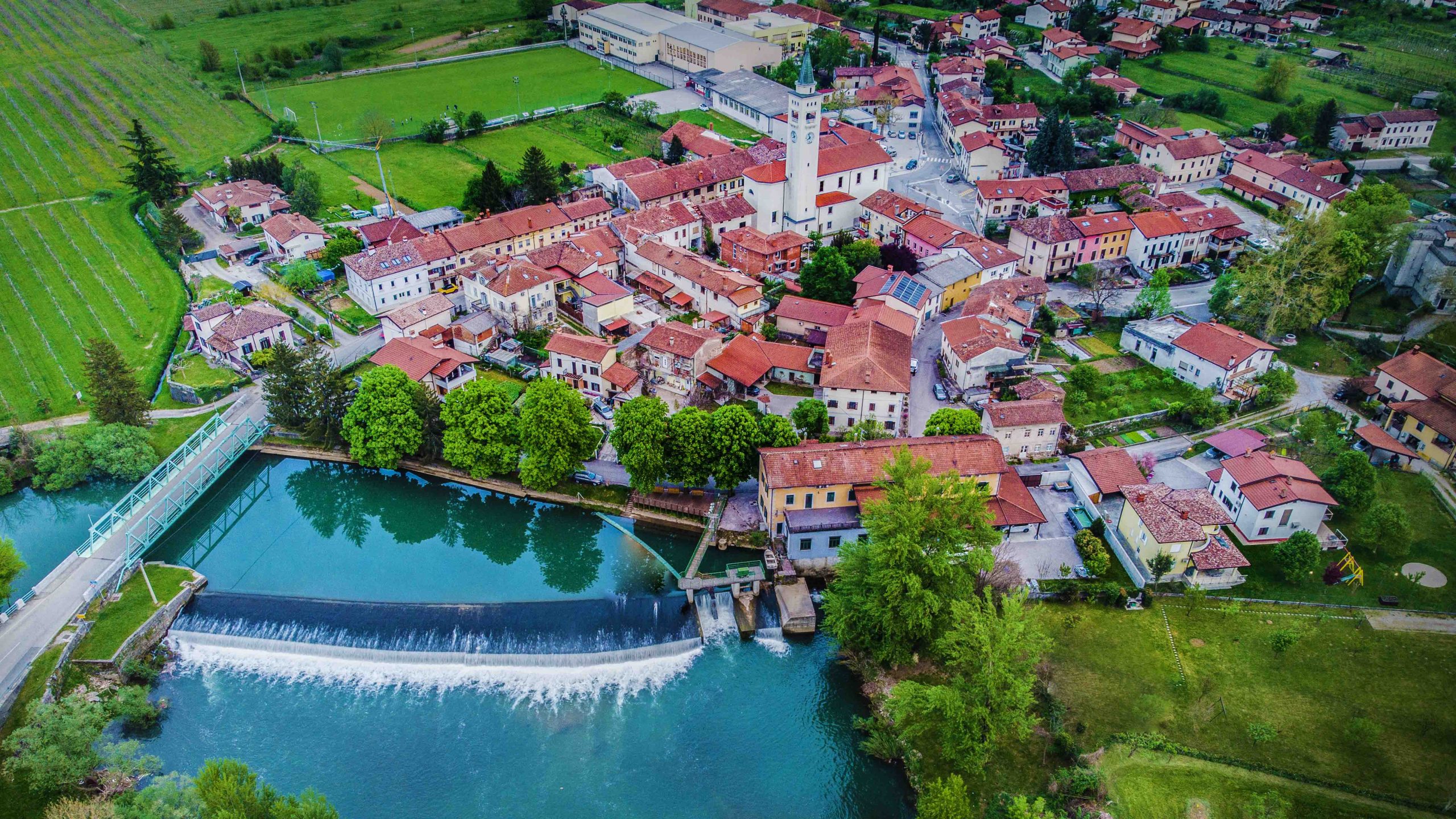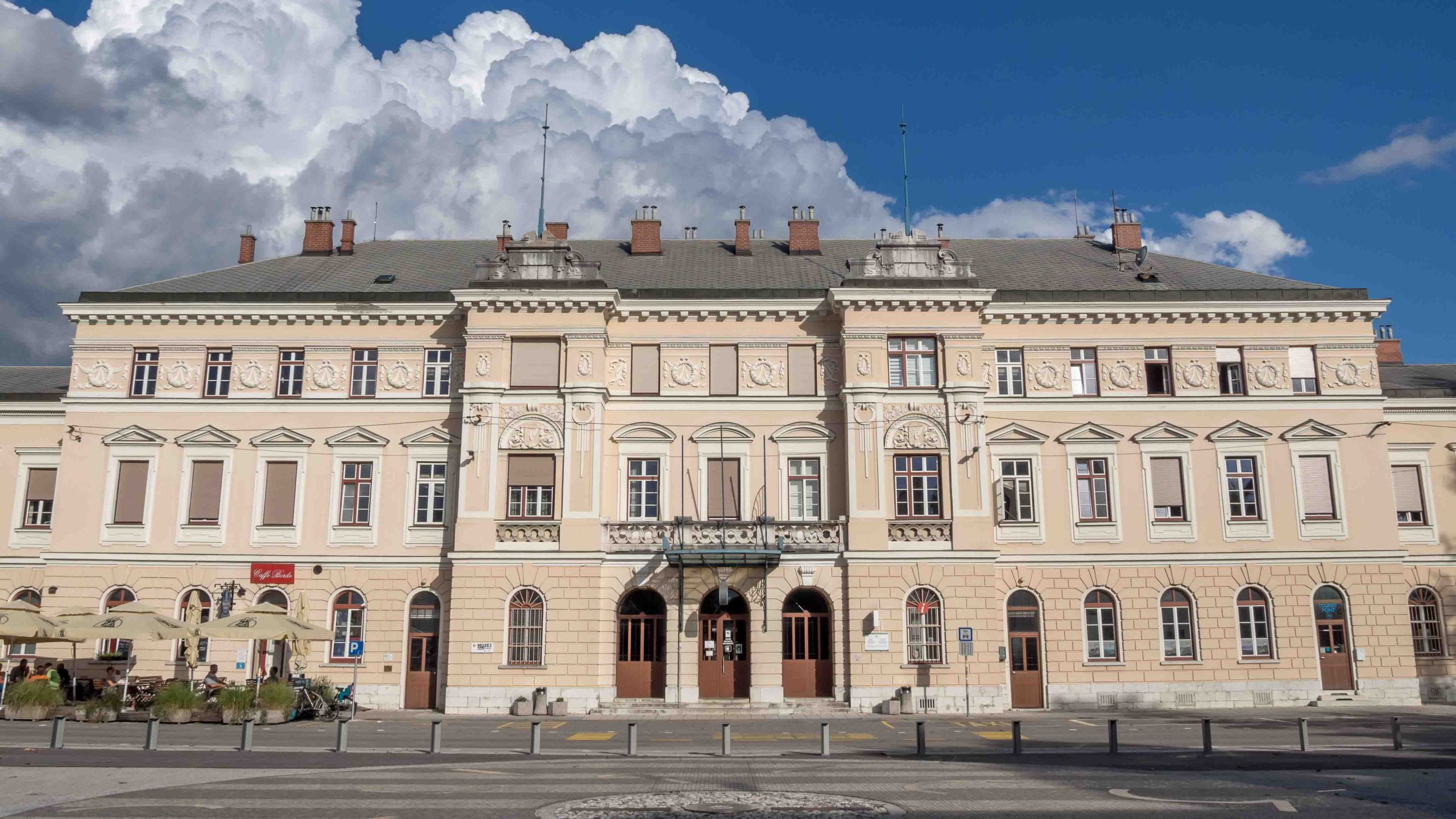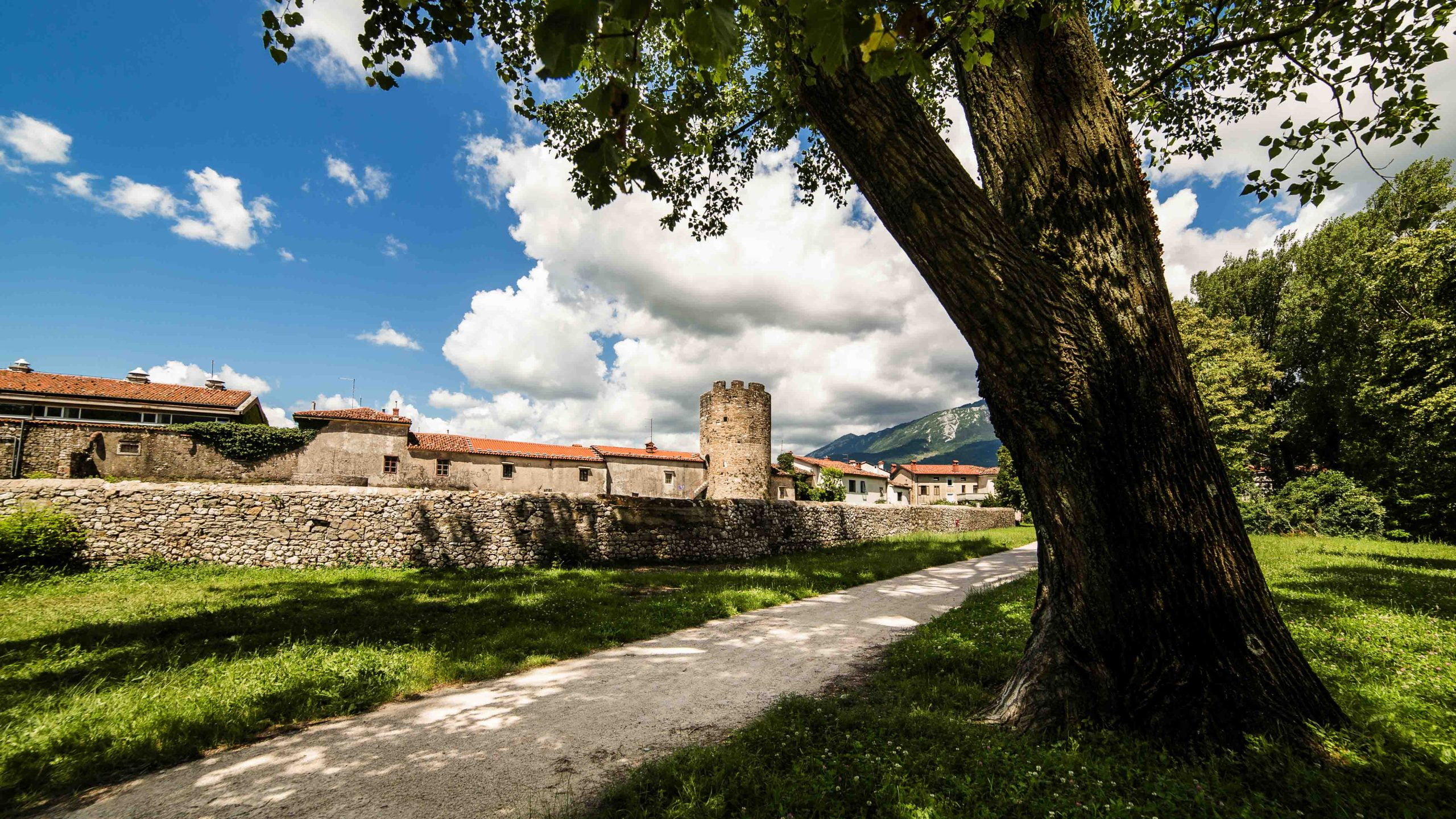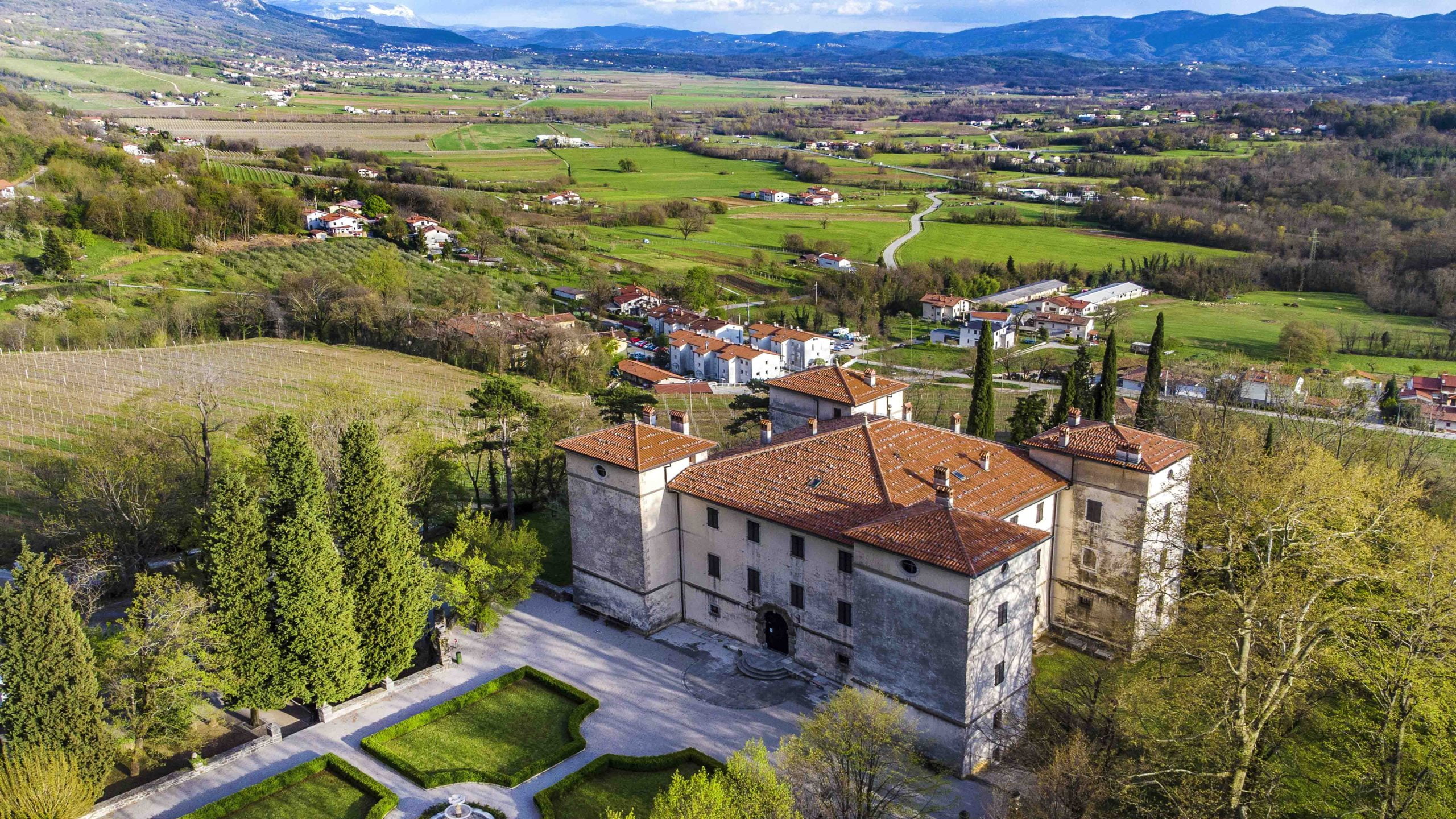The Vipava Valley is an area of outstanding beauty in the northwest corner of Slovenia, close to the border with Italy. It’s just starting to become known as a foodie’s paradise – but it’s also a little-known Slovenian cycling paradise.
Only an hour’s drive from Ljubljana and 45 minutes from Trieste, cyclists visiting Slovenia’s Vipava Valley will find high limestone plateaus, fertile hillsides covered in vines and villages where sustainability is a way of life rather than a catchphrase.
The valley also boasts varied cycling routes, spectacular scenery and some seriously good food and wine (two of the country’s ten Michelin starred restaurants are in the Vipava Valley).
What better combination for a cycling holiday?
We were delighted to find that Vipava Valley’s enlightened tourism board were keen to promote their region to us cyclists. In this article we speak to Maja Herak, who shares the things you need to know when planning a cycling trip to Slovenia’s Vipava Valley.
Why should cyclists visit Slovenia’s Vipava Valley?
Overview
The Vipava Valley is for cyclists that love wine, good food, local inns and agritourism farms. Surrounded by high karst plateaus and wine-growing hills, it’s a beautiful place that’s also blessed with castles, manors and churches.
It’s a traditional region with a unique charm that will appeal to anyone looking for a quieter pace of life from their cycling holiday. Here there’s an aroma of traditional custom and a common thread of hospitality.
Geography of the region
The Vipava Valley lies in a unique spot on the western edge of Slovenia, a stone’s throw from the Italian border, half an hour from the Gulf of Trieste and an hour to the Julian Alps. It lies in the heart of Europe.
The Vipava Valley itself is flat, but it’s surrounded with plateaus and hills. In the west, the Vipava Valley opens up into the cross-border Goriška Region and Italy (Friuli Venezia Giulia). The Vipava Valley is enclosed in the north by The Trnovo Forest Plateau, and in the south by the rolling Vipava Hills and the Karst Plateau.
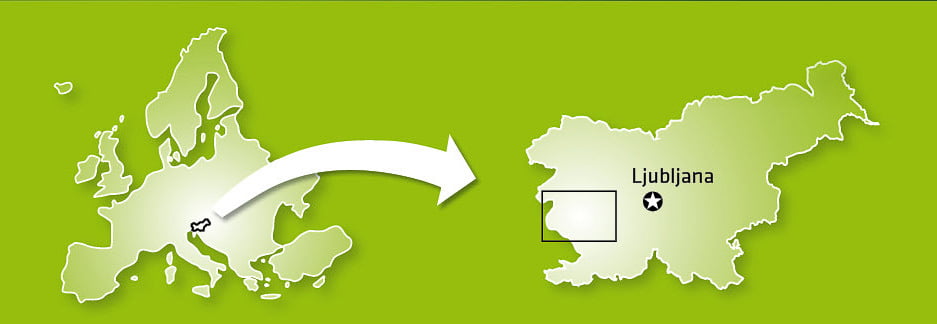
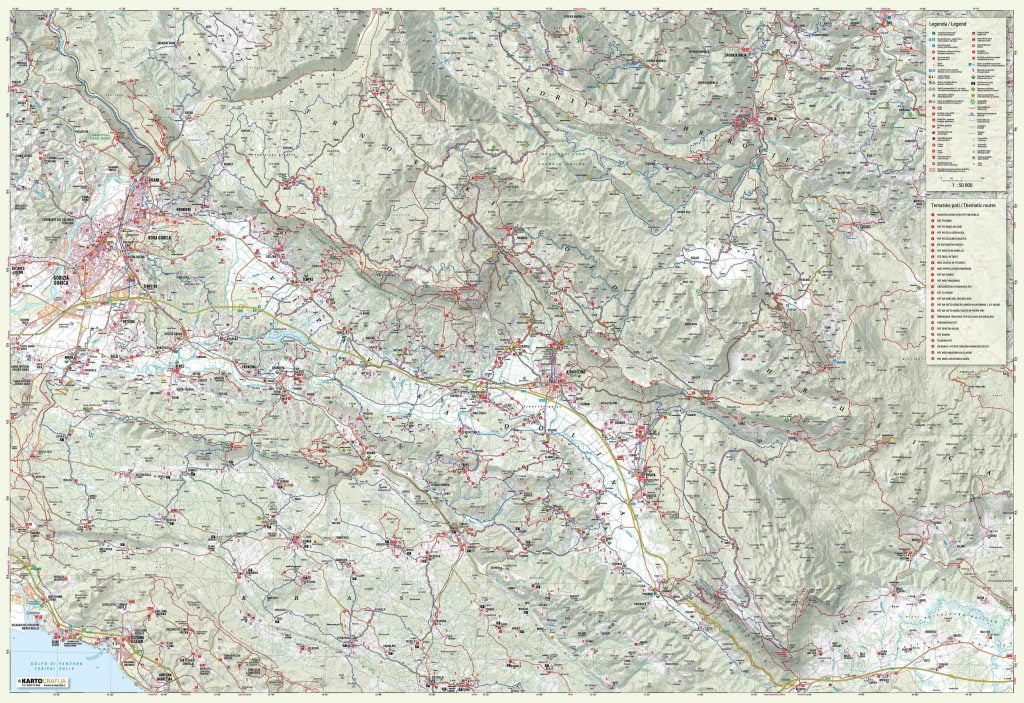
(Map credits: Nova Gorica in Vipavska dolina)
Main towns
Ajdovščina, Vipava and Nova Gorica are the major towns in the Vipava Valley.
Bear in mind that these are not huge places – for example, Ajdovščina has a population of 6,600 and Vipava, just 7 kilometres away, has a population of 1,950.
Nova Gorica lies right on the border with Italy. Gorizia is in Italy and Nova Gorica is in Slovenia; there’s a seamless border between the two countries, through Europe Square. It has grown into a lively university city and they’ve joined up to become the joint European Capital of Culture for 2025, the first cross-border cities to do this.
What are the roads like?
Cyclists are welcome in the Vipava Valley and drivers on the roads are mindful of cyclists. This is a peaceful part of the world so the lack of heavy traffic and traffic jams helps with tolerance between road users.
The roads are generally in good condition. The bigger towns have cycling paths and more infrastructure is being constructed.
Tell us about the Vipava Valley’s cycling routes
We are keen to encourage cyclists to visit our valley and have developed routes for leisure cyclists, road cyclists and mountain bikers. These can be found here.
Below we talk in a little more depth about each of the four road cycling routes we’ve developed:
The Lower Vipava Valley
This easy loop ride starts and finishes in the heart of Nova Gorica. It runs around the lower Vipava Valley to Dornberk and back to Nova Gorica, passing Miren Castle and Kostanjevica Monastery. Note that there are around 800 metres of unpaved surfaces.
GPX DownloadTerms of use reminder
Route highlights
Europe Square in Nova Gorica
To celebrate the Slovenian accession to the European Union in 2004, the Slovenian city of Nova Gorica and the Italian city of Gorizia inaugurated Europe Square, which lies right on the border between the two countries. The centre piece of this square is the Mosaic of the New Europe. Today, Europe Square is a symbol of European integration.
Kostanjevica Monastery in Nova Gorica
Kostanjevica is a complex with a church, monastery and library. Under the church presbytery are the tombs of the last members of the French line of Bourbon kings, including the last French King, Charles X. The Škrabec library has around 10,000 books and even 30 incunabula; the oldest one dates to 1476. The library also holds the Slovenian grammar book by Adam Bohorič, written in Latin from 1584, with an inscription of the author himself.
Miren Castle is in fact a monastery, not a castle. The entire church interior was furnished with frescoes and sculptures by one of the leading Slovenian expressionists, Tone Kralj. There are stunning views from the hillside.
Café stops
- Gostilna pri hrastu in Nova Gorica
- Gostilna Žeja in Ozeljan
- Picerija Grad in Ozeljan
- Agritourism farm Malovščevo in Vitovlje
- Agritourism farm Arkade in Črniče – it’s one of the best known in Slovenia
- Gostilna Kogoj in Bilje
Please, bear in mind that agritourism farms are open just during the weekends – some may require prior appointment.
More information
You can read more about the route here.
The Branica Valley
Another easy route, which starts and finishes in the old centre of Vipava. Note the route includes 1.2 kilometres of unpaved surface.
GPX DownloadTerms of use reminder
Highlights
The spring of the river Vipava and the town of Vipava
The source of the Vipava River, which gave its name to the Vipava Valley, is very special. The river surfaces in several springs in the small town of Vipava and forms an inverted delta. Vipava is an ancient town with beautiful architecture and picturesque bridges. The Baroque Lanthieri Mansion dominates on the main town square. Today, Vipava is the undisputed capital of Vipava Valley wine.
More information here.
Goče is a gorgeous example of typical rural architecture. The houses feature thick walls made of stone, the roofs are covered with pan tiles and occasionally stone roof slates. The village lanes are truly special. Other than two main streets, all lanes are extremely narrow and usually not more than one metre wide. Goče is also well-known for its 60+ wine cellars, with vaulted ceilings and built from the local stone. During the heyday, each winemaker operated two or more cellars.
Rihemberk Castle
Built on the site of a prehistoric fortress, the castle seen today was built in the late 12th century. The Lanthieri family acquired it in the mid-17th century and gave the castle its final look. In recent decades, the castle has become a home to bats. Of the 28 species of bats currently living in Slovenia, nine species regularly inhabit Rihemberk Castle, making it one of the country’s most important bat refuges.
Castra fort was built in the second half of the 3rd century and early 4th century, as part of the Roman defence system on the east frontier. Ajdovščina has managed to retain its Roman enceinte with 14 towers almost fully intact. Fortress Castra acted as an important military centre with a permanent military crew and command.
Zemono manor hours is thought to have been built to function as a wine cellar and entertainment venue by the Counts of Lanthieri in around 1683. Today, the manor houses the celebrated restaurant Gostilna pri Lojzetu, famed for its refined Michelin-starred food.
Café stops
Gostilna Podfarovž in Vipava
Ošterija Branik in Branik
Agritourism farm Domačija Lisjak 1956 in Zalošče
More information
You can read more about the route here.
Gora Plateau
For something more challenging, this ride takes you on a stiff climb up to the Gora Plateau. The route starts and finishes in the centre of Ajdovščina. Note that there are around 500 metres of unpaved surface.
GPX DownloadTerms of use reminder
Highlights
See information above.
The spring of the river Hubelj
In its upper reaches, the Hubelj River has an alpine character with a pebbled river bed and steep descents, which is quite uncommon in the Vipava Valley. On the river banks is the educational Ob Hublju Nature Trail, which leads from the town to the spring. The water of the Hubelj is of superb quality, which is why it has been supplying potable water to the Vipava Valley for well over a century. In the sixteenth century, the river was also used as a power source which allowed industry to spring up along the river banks; today you can spot the restored ruins of the ironworks close the Hubelj’s source.
The Tunnels of Mt Čaven
In the past, the Gora Plateau’s only connection to the Vipava Valley was a set of steep walking trails. The first road into the Valley was designed by Josef Ressel (1837), the inventor of the screw propeller. In 1897 a new picturesque road was built, featuring a bridge and three tunnels carved into bedrock.
Monument to the Mother of the Gora Plateau in Predmeja
This monument depicts a mother fetching water, the source of life, to bring it up to the Gora Plateau. The site offers commanding views of the Valley, Mt Nanos, Mt Čaven, Karst and the Gulf of Trieste.
This natural geological feature is around 12 metres high and 7 metres wide. The locals call it simply The Hole. The natural window opens up a peculiar view of the Vipava Valley. There is a smaller window located a bit further downhill.
Karren under the summit of Sinji vrh
Just off Col–Predmeja road is another eye-catching feature: the prominent karren that were carved into the thick strata of limestone, overlain with weathered debris. Because of this, their surface is smooth and rounded into unusual shapes. These karren have been declared a natural monument of national importance.
Café stops
Gostilna pri izviru Hublja in Ajdovščina (at the spring of the river Hubelj)
Gostilna Tratnik in Col
More information
You can read more about the route here.
Sveta Gora
Shorter than the Gora Plateau ride, but also demanding, this route starts and finishes in Nova Gorica. Note that the route includes around 300m of unpaved surfaces.
GPX DownloadTerms of use reminder
Highlights
Europe Square in Nova Gorica
See information above.
Kostanjevica Monastery in Nova Gorica
See information above.
Kromberk Castle is a Renaissance building with an almost square floor plan and four corner towers that make for an impressive sight. The original castle dates from the early 13th century. In the early 17th century it was acquired by aristocrat Ivan Marija Coronini who commissioned its present form. The Castle showcases permanent art exhibitions and cultural history exhibitions. It also has space for temporary exhibitions and is surrounded by a park with amphitheatre and outdoor lapidarium.
Sveta Gora (meaning “holy mountain” in Slovenian) is a well-known pilgrimage site, and home to a Franciscan monastery. To reach Sveta Gora you can also use a hiking trail that partly runs through the tunnels and trenches made by soldiers as part of the infamous Isonzo Front in WW1.
Solkan Bridge has a span of 85 metres and is the world’s longest stone arch railroad bridge. It was finished in 1905, as part of the Bohinj Railway between Gorica and Jesenice.
Café stops
- Gostilna pri hrastu in Nova Gorica
- Gostišče Oddih in Solkan
- Ošterija Žogica in Solkan, near the Solkan Bridge
More information
You can read more about the route here.
Additional cycling routes
Along the Slovenia-Italy border
Fields and vineyards around Sveti Martin
Up and down the Vipava Hills
What are the key road cycling events in the Vipava Valley?
For a small region, the Vipava Valley has attracted an unusual number of cycling events.
Giro d’Italia
In 2021, part of the 15th stage of the Giro d’Italia took place in the Vipava Valley. More information here.
Tour of Slovenia
In 2022, 2021 and 2019, Slovenia’s biggest cycling race, “The Tour of Slovenia” visited the Vipava Valley. With stages located across different parts of Slovenia, the famous “green loop” has been held under the motto “Fight for green” for several years now.
In 2021 and 2019 the queen stage of the Tour of Slovenia took place in the Vipava Valley, each time with one famous ascent: in 2021 from Nova Gorica to Mt Sveta Gora and in 2019 from Ajdovščina to Predmeja.
Grand Prix Vipava Valley & Crossborder Goriška
The second edition of the new elite cycling race “Grand Prix Vipava Valley & Crossborder Goriška” will be held on 23th March 2023. Last year cyclists had to cover 155 km across the Vipava Valley.
What are the best hotels and accommodation options for cyclists in the Vipava Valley?
Most hotels and accommodation in the Vipava Valley will do their best to accommodate cyclists and many will offer bicycle storage.
However the following places give cyclists a particularly warm welcome:
Hotels
Youth hostel Ajdovščina, Ajdovščina
Hotel Sabotin, Solkan
Hotel Gold Club, Ajdovščina
Hotel Lipa, Šempeter pri Gorici
Agritourism farm Malovščevo, Vitovlje
B&B Alba, Lokavec
Campsites
Kamp David, Malovše
Saksida Wine & Camping Resort, Zalošče
Kamp Ajdovščina, Ajdovščina
Kamp Park Lijak, Ozeljan
Kamp Tura, Gradišče pri Vipavi
You can browse many kinds of accommodation on the tourist board’s website, here.
Are there places for bike hire/bike shops in the Vipava Valley?
The main bike rental services in Vipava Valley are Wajdušna, Rock Velo, Dim bikes, MSM Logistika and Cycling Holidays by Exploremore.
Their addresses and websites are listed here. Other providers you see listed are accommodation that offer bike rental and businesses with other types of sport equipment rentals. Please take care to check exactly what kind of bike rental is offered – if you’re looking for a particular spec of road bike you might be disappointed!
Some hotels also offer bike rentals, including:
- Hotel Sabotin, Solkan
- Hotel Lipa, Šempeter pri Gorici
- Hotel Gold Club, Ajdovščina
- Youth hostel Ajdovščina
If you’re looking for a bike shop, you can find them in Ajdovščina and Nova Gorica. There’s also one in Solkan and one in Šempeter pri Gorici.
- Kamplc sport: Gregoričičeva ulica 10, 5270 Ajdovščina, +386 5 99 52 934, info@kamplc.net
- Velocenter Ajdovščina: Štrancarjeva ulica 3, 5270 Ajdovščina, +386 5 366 31 77, velo.ajdovscina@velo.si
- Bisport: Gradnikove brigade 53, 5000 Nova Gorica, +386 5 302 82 78, info@bisport.si
- DJAK: Rejčeva ulica 24, 5000 Nova Gorica, +386 5 333 46 33, +386 41 320 941, info@djak.si
- Kult Solkan, Velika pot 21, 5250 Solkan, +386 40 264 330 (for the shop), +386 40 264 330 (for bike service), info@kultsolkan.com
- Kolesarski center Šempeter, Žnidarčičeva ulica 21, 5290 Šempeter pri Gorici, +386 5 393 65 37
When to visit the Vipava Valley?
The Vipava Valley’s message is “Different. All year round.” Any time of year is the right time to visit.
The Vipava Valley has a very pleasant climate. The summers are hot, the winters gentle, the spring comes early and is often sunny. However, be aware of the valley’s burja wind, a powerful north-eastern wind. The burja occurs over the Vipava Valley when a high pressure cell is present over Central Europe and generally pushes the cold air from the inland toward the hills and into the lowlands. Generally it occurs during winter months. More information below!
On the plateaus encircling the valley the atmosphere is quite different, being a mixture of the Alpine, Continental and Mediterranean climates. The Trnovo, and Nanos Plateaus boast fresh summers and some snowfall in winter.
More about the burja wind
The burja wind varies in force. Sometimes it blows 20 km/h, sometimes it’s like a hurricane (the record is 235 km/h). When the burja reaches strong gusts (more than 100 km/h) the freeway is closed for lorries and caravans.
The burja wind is most common at the end of November and at the start of December, but it can occur until April. On average there are 40 days of burja per year and it lasts for just a day or two, rarely for a week.
The burja isn’t as strong or as frequent nowadays as it was in the past. It is nothing to be scared of, this isn’t the type of wind that would come all of a sudden and surprise someone out cycling.
The wind is stronger in the upper Vipava Valley (Vipava, Ajdovščina) and it gets weaker the more you move West. It’s not unusual to experince burja in -let’s say- the town of Vipava, while in the town of Nova Gorica there isn’t even a breeze.
The burja is a true landmark here. The locals take it in stride. The dwellings and villages are designed to withstand the burja. The roof tiles on older houses are weighed down with rocks, and the doorways are usually located on the side facing away from the wind. You’ll notice the trees on the Gora Plateau growing sideways because they are withstanding the gusts.
Burja is also linked with history. According to legend, in the year 394 AD, it was the burja wind that gave the decisive blow in the battle between the armies of the Roman Emperor Theodosius and his opponent Eugenius, which took place in the Upper Vipava Valley. It turned the events into Theodosius’s favour, signalling the final triumph of Christianity in the Roman Empire.
Events
If you want to time your visit with a food/wine related event, it’s worth knowing that twice a year, many of the local farms and wine cellars open their doors for the Slovenian tradition of Osmica. During this time, you can sample their wine and homemade produce. There’s more information here.
If you want to time your cycling trip with a festival or event, here are some to consider:
The ultra marathon takes place over one weekend in May and includes 5,550 metres of ascent.
In summer, the winemakers of the Vipava Valley traditionally open the doors of their wine cellars to welcome guests for wine tasting and snacks.
Festival of Vipava Valley Wines
In August at the Festival of Vipava Valley Wines, winemakers from across the country present their wines. The event is accompanied by traditional local dishes and a cultural program. The castle walls and scenic little alleys of Vipavski Križ make a beautiful setting.
In June, the medieval gem Vipavski Križ hosts winemakers from the Vipava Valley, who produce the Zelèn wine. There is also an organised tour of the alleys and piazzas of Vipavski Križ.
In May, Nova Gorica, the town of roses, hosts a festival celebrating roses accompanied by a rich programme and culinary offer. The central venue is the garden of the Franciscan Monastery Kostanjevica that hosts a fabulous collection of old-school Bourbon roses. The garden is open only during the festival, daily from 9 am to 5 pm.
Month of Local Cuisine: The Flavours of the Vipava Valley
The Month of Local Cuisine is a staple of the annual festival Flavours of the Vipava Valley main event. In April and May many restaurants, inns and agritourism farms in the Vipava Valley offer guests selected dishes made from locally sourced ingredients.
Vipava Valley Wine Cellars between St. Martin’s Day and Christmas
November ushers in the season of traditional St. Martin’s feasts and many other events dedicated to wine. These occur all the way up to Christmas. Some villages in the Valley hold collective St. Martin feasts, and other villages pick a day where all their winemakers invite guests in for a tasting.
Any tips for cycling holidays in the Vipava Valley?
Cycling maps
The Vipava Valley cycling map may be useful – you can find it here or in tourist information centres in the Vipava Valley.
Highway Code rules
You can read Slovenia’s rules of the road and bike safety laws here.
Travel around the valley
You might find having a car is convenient when staying here, especially because public transport is scarce.
Food
When visiting the region, you should definitely try the typical jota stew, dry cured meats (salami and Vipava Valley prosciutto). Indeed, Vipava Valley’s air-dried prosciutto rivals the quality of the more famous Italian equivalent.
Also well worth trying are the walnut štruklji (rolled dumplings). Frittata and polenta, with various toppings, are available year-round. As well as the heavier meats and stews, the valley is filled with orchards heaving with apricots, peaches and persimmons.
There’s more information on our local delicacies here and here.
Two of Slovenia’s Michelin-starred restaurants are in the Vipava Valley: Dam in Nova Gorica and Gostilna Pri Lojzetu in Dvorec Zemono Manor House, near Vipava.
Culture
If you like to combine culture with cycling, there’s plenty to see. The highlights mentioned under the routes section above give a good taste, but by way of summary:
The ruins of the 11th century Vipava Castle offer fantastic views over the town.
In Ajdovščina, you’ll find the remains of the Roman Castra fortress near the Hubelj River. It was built around the 3rd century and is the largest surviving Roman wall in Slovenia. The nearby Ajdovščina Museum Collection has more information on the Roman legacy.
To the west is the lovely mediaeval hilltop village of Vipavski Križ. It began as a village in the 13th century before a castle and defensive wall were built to protect the village from the Ottomans. It then grew into a busy trade centre. Today you can still explore the castle walls, bell towers and library of the 17th-century Capuchin monastery, with its rare manuscripts and baroque art.
Finally, there’s Rihemberk Castle, which looks out over the village of Branik and the mountains. The castle has the tallest castle tower in Slovenia and occupies an impressive situation.
There’s more information on the Vipava Valley’s cultural heritage and monuments here.
Other outdoor activities
Want to combine cycling with other outdoor activities? You can find out more about hiking, fishing and more adrenaline-inducing activities in the Vipava Valley here.
How to get to Slovenia’s Vipava Valley?
A modern and efficient highway system connects the Vipava Valley to the rest of Slovenia, as well as the coast, Italy, the Soča Valley, and other regional roads.
This network also puts it close to nearby air traffic hubs, with five international airports within a 160-km radius; the closest is less than an hour away.
The most convenient way to arrive in the Vipava Valley are its nearby airports. From there you can rent a car to the Vipava Valley.
A huge thank you to Nova Gorica and Vipava Valley Tourist Board for sharing these insights into this wonderful part of the world. We hope to visit soon!The r
Got a question for Maja?
Fill out this form and we will send it to Maja. We aim to get you an answer within 24 hours wherever possible!
The contents of this website are provided for general information purposes only. It is not intended to amount to advice and you should not rely on it. You should carry out your own due diligence and risk assessments and take professional advice. Views expressed by interviewees or other users of this website do not necessarily represent our views. We make no representations, warranties or guarantees, whether express or implied, that the content on our website is accurate, complete or up to date. If you use any information or content on this website, download from, or otherwise obtain content or services through our website, it is entirely at your own discretion and risk. Epic Road Rides Ltd disclaims all liability and responsibility arising from any reliance placed on the information and content on this website. Find out more here.
Vipava Valley tourist board was founded in 2018. Vipava Valley is a boutique, green, healthy and sustainable tourist destination. Visitors to our destination want to enjoy life and relax throughout the year.
Our valley is known for its sunny wine-growing hills, exceptional wine tradition, excellent cuisine and rich natural and cultural heritage. The cities Nova Gorica (Slovenia) and Gorizia (Italy) are named the European Capital of Culture for 2025.
The Valley has the power to enrich visitors via unique tastings, authenticity and hospitality. This is why we promote our Valley as a Paradise Valley.
Among wine destinations we offer the most options for outdoor activities, and cycling is the most popular among them.







